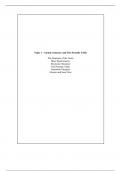Topic 1 - Atomic structure and The Periodic Table
The Structure of the Atom
Mass Spectrometry
Electronic Structure
The Periodic Table
Ionisation Energies
Atomic and Ionic Size
, THE STRUCTURE OF THE ATOM
a) Protons, neutrons and electrons
Atoms are made up of three fundamental particles: protons, neutrons and electrons.
Protons and neutrons are found in the nucleus and are collectively called nucleons.
Electrons orbit the nucleus in a similar way to that in which planets orbit a sun. In
between the electrons and nucleus there is nothing (empty space).
The nucleus is very small; if an atom were the size of a football pitch, the nucleus
would be the size of a drawing pin.
The basic properties of these three particles can be summarized in the following table:
Particle Charge Mass
Proton +1 unit Approx 1 unit
Neutron No charge Approx 1 unit
Electron -1 unit Approx 1/1840 units (very small)
1 unit of charge is 1.602 x 10-19 coulombs. A proton is given a charge of +1 and an
electron a charge of -1. All charges are measured in these units.
1 unit of mass is 1.661 x 10-27 kg. This is also not a convenient number, so we use
“atomic mass units”.
Since the mass of protons and neutrons varies slightly depending on the nucleus, then
in order to define an “atomic mass unit” we need to choose one nucleus as a standard.
For this purpose 126C , or “carbon-12”, was chosen because its mass per nucleon
(1.661 x 10 –27 kg) is around average, which means all the other nuclei have masses
close to whole numbers. An atomic mass unit is thus defined as 1/12th of the mass
of one atom of carbon-12. Everything else is measured relative to this quantity.
b) Atomic numbers, mass numbers and isotopes
An atom is named after the number of protons in its nucleus. If the nucleus of an atom
has 1 proton, it is hydrogen; if it has two protons, it is helium; if it has 3, it is lithium
etc. The number of protons in the nucleus of an atom is called the atomic number. It
has the symbol Z.
The atomic number is the number of protons in the nucleus of an atom
, Not all atoms of the same element have equal numbers of neutrons; this may vary
slightly. The sum of the number of protons and neutrons in the nucleus of an atom is
called its mass number. It is represented by the symbol A.
The mass number is the sum of the number of protons and neutrons in the nucleus of
an atom
The nucleus of an atom can thus be completely described by its mass number and its
atomic number. It is generally represented as follows:
A
ZE
Eg. 94Be, 126C, 2412Mg
Atoms with the same atomic number but with different mass numbers (ie different
numbers of neutrons) are called isotopes.
Isotopes are atoms with the same atomic number but with different mass numbers
Eg magnesium (atomic number 12) has 3 naturally occurring isotopes:
24
12 Mg: 12 protons, 12 neutrons
25
12 Mg: 12 protons, 13 neutrons
26
12 Mg: 12 protons, 14 neutrons
In a neutral atom, the number of protons and electrons are the same. However, many
elements do not exist as neutral atoms, but exist as ions. Ions are species in which the
proton and electron numbers are not the same, and hence have an overall positive or
negative charge. The number of electrons in a species can be deduced from its charge:
Eg
24
12 Mg2+: 12p, 12n, 10e
24
12 Mg+: 12p, 12n, 11e
24
12 Mg 12p, 12n, 12e
24
12 Mg-: 12p, 12n, 13e
Ions with a positive charge are called CATIONS
Ions with a negative charge are called ANIONS.




